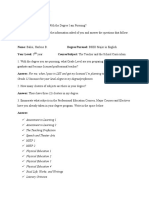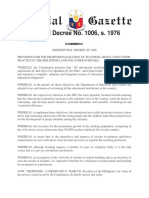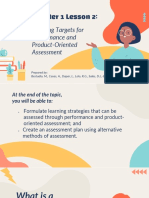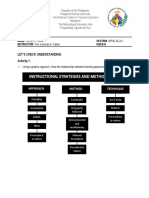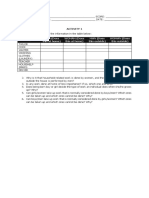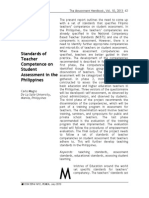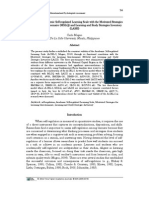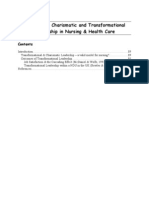A Guide in Assessing Knowledge, Process, Understanding, and Performance/Product (KPUP)
A Guide in Assessing Knowledge, Process, Understanding, and Performance/Product (KPUP)
Uploaded by
Carlo MagnoCopyright:
Available Formats
A Guide in Assessing Knowledge, Process, Understanding, and Performance/Product (KPUP)
A Guide in Assessing Knowledge, Process, Understanding, and Performance/Product (KPUP)
Uploaded by
Carlo MagnoCopyright
Available Formats
Share this document
Did you find this document useful?
Is this content inappropriate?
Copyright:
Available Formats
A Guide in Assessing Knowledge, Process, Understanding, and Performance/Product (KPUP)
A Guide in Assessing Knowledge, Process, Understanding, and Performance/Product (KPUP)
Uploaded by
Carlo MagnoCopyright:
Available Formats
118
Educational Measurement and Evaluation Review (2014), Vol. 5, 118-127
2014 Philippine Educational Measurement and Evaluation Association
A Guide in Assessing Knowledge, Process, Understanding,
and Performance/Product (KPUP)
Carlo Magno
Asian Psychological Services and Assessment
Gabriel Sebastian Lizada
Ateneo de Davao University
Abstract
The aim of the present report is to provide a guide for educators in
assessing knowledge (K), process (P), understanding (U), and
product/performance (P) as part of the reform in assessment in the
K to 12 basic education. The Philippines recently changed their
basic education system to a one year of kindergarten and 12 year
basic education known as the K to 12 Enhanced Basic Education.
Part of the educational reform is a guide on how to conduct
assessment in schools within a framework of Standards-Based
Assessment. The new assessment system established a nomenclature
of skills to be assessed among students that includes assessment of
knowledge, process, understanding, and product/performance. The
present report further defines and clarifies the domains of the
nomenclature. The specific dimensions of these skills are outlined
with some examples of assessment protocols under each.
Keywords: KPUP, Assessment, Knowledge, Process, Understanding,
Performance/Product
Education in the Philippines has reformed to the K to 12 Enhanced Basic
Education. Part of this reform is the development of a system of assessing
student learning. The Department of Education (DepEd) developed a set of
skills that needs to be assessed in the classrooms that is presented in a
nomenclature composed of knowledge, process, understanding, and
performance/product. This nomenclature was proposed in order to develop the
necessary skills of school children. In the past curriculum, educators use
different taxonomies that guide their assessment of students learning such as
the revised Blooms taxonomy, Gagnes Taxonomy, Stiggins and Conklins
Taxonomy, Marzanos dimensions of learning, DeBonos six thinking skills, and
ISSN 2094-5876 Educational Measurement and Evaluation Review (EMEReview), July 2014
119
others. The new curriculum provides standards and a mechanism how to assess
appropriately these standard skills. The specific domains of the nomenclature
are based on some aspects of existing taxonomies. For example, the knowledge
domain is similar with the recalling component of Bloom and Marzano. The
understanding domain is based on the six facets of understanding by Wiggins
and McTighe (2005). The process skills are based on theories of metacognition
and self-regulation stemming from the work of Flavell (1979), Zimmerman
(1999) and similar with the metacognitive system of Marzano.
The most popular taxonomy used in Philippines is Blooms Taxonomy and
the revised Blooms Taxonomy (Anderson, et al., 2000). Blooms taxonomy is
divided into six cognitive levels, each increasing in complexity. The six levels
are separated into two levels. The first level includes knowledge,
comprehension and application with knowledge being the lowest and simplest
cognitive skill. The other level is for analysis, synthesis and evaluation with
evaluation being the most complex cognitive skill. Years after Lorin Anderson,
a student of Bloom, revised the current taxonomy to rename it into the revised
Blooms taxonomy with minor changes in terms (Knowledge became
Remembering, Comprehension became Understanding, Application became
Applying, Analysis became Analysing, Synthesis became Evaluating, and
Evaluation became Creating) but with significance (Forehand, 2012). Gagnes
taxonomy provided another lense in viewing skills in terms of learning
capabilities. These five are intellectual skills, cognitive strategies, verbal
information, attitudes, and motor skills (Gagne & Briggs, 1979).
The Department of Education proposed that students need to be
assessed on the domains of knowledge, understanding, process, and
product/process (DepEd Order No. 31, s. 2012). This nomenclature were made
in order for the students to reach the content and performance standards of
the curriculum. The assessment system is described to be holistic where
teachers use both formative assessment and summative assessment. Formative
assessment involves students accomplishing a bank of items accompanied by a
series of feedback; it is non-threatening and provides students a series of
practice for the mastery of the lesson; it reinforces students understanding and
interest in the subject matter (Black & William 2003; Gonzales & Birch, 2000).
Kulik and Kulik (1998) explained that the best assessment practice incorporates
several assessment and feedback that enhances students learning. The nature
of formative assessment provides a more authentic nature of student learning
because it is a combination of what the students know and monitoring their
progress. In a study done by Nicol and Macfarlane-Dick (2006) posited that
formative assessment can lead to self-regulated learners. Students will be able
to monitor and evaluate themselves during the learning session. In the same
study, both authors came up with seven principles to help educators enhance
self regulated learners in higher education. These principles (Nicol &
Macfarlane-Dick, 2006, p. 200):
(1) helps clarify good performance, (2) facilitates development of self
assessment, (3) delivers high quality information to students about their
ISSN 2094-5876 Educational Measurement and Evaluation Review (EMEReview), July 2014
120
learning, (4) encourages teacher and peer dialogue, (5) encourages
positive motivational beliefs and self-esteem, (6) provides opportunities
to close the gap between current and desired performance and (7)
provides information to teachers that can be used to shape teaching.
On the other hand, summative assessment is given when students have
mastered the lesson, to determine the learners achievement on a unit or
course. In one study (Herppich, Witter, Nuckles, & Renkl, 2014), summative
assessment and formative assessment worked together to enhance knowledge
and learning of the learner. The results of the study showed that tutees that
have teaching experience were more accurate in providing summative
assessment to their learners as compared to the tutees who had no teaching
experience. In this case, formative assessment was used as a method
(feedback) in which the tutee can assess the summative assessment of the
learner that showed improved accuracy with understanding after the tutor.
Formative assessment is emphasized in the new assessment system in
order to help students reach the standards. Through a series and multiple
assessments, the teacher is able to see the immediate evidence what students
have learned and therefore be able to design and adjust the instruction based
on their needs.
Assessment in the K to 12 becomes more useful to help students learn
better. This brings in mind the idea of assessment for learning. According to
Stiggins (2001) when we assess for learning, teachers use the classroom
assessment process and the continuous flow of information about student
achievement that it provides in order to advance, not merely check on, student
learning (p. 5). This process requires teachers to become assessment literate
where they should have the ability to transform their expectations into
assessment activities and utilize the assessment results to further improve their
instruction and eventually student learning. Following up on the study by
Stiggins (2001), Chappuis and Stiggins (2002) forwarded the idea of a studentinvolved assessment in which students know that feedback on the assessment
processes is used on them. This idea according to Chappuis and Sitiggins (2002)
will help students with opportunities to communicate and check progress on
their own. This will eventually lead to a better classroom for both the teacher
and the student
Through formative assessment, the process of assessment becomes
closely integrated with instruction and becomes instruction itself. Teachers
may provide activities through games, small groups, exercises that immediately
provide information on how the teacher begins her instruction. The teacher
after teaching some small bits of skills follow with immediate assessment to
determine if the lesson will be repeated or who among the students need
further help. The actual activities in the classroom such as games can provide
information to the teacher about what the students can and cannot do.
ISSN 2094-5876 Educational Measurement and Evaluation Review (EMEReview), July 2014
121
Assessing Knowledge
Knowledge is defined by the Department of Education (DepEd Order No.
31, s. 2012) as facts and information that students need to acquire. The
knowledge domain contains similar skills with Blooms taxonomy that includes
defining, describing, identifying, labeling, enumerating, matching, outlining,
selecting, stating, naming, and reproducing. Examples of questions to assess
the knowledge domain would include the following examples:
Table 1
Example of Questions for Knowledge
Learning Areas
English
Mathematics
Science
Social Studies
Filipino
Performance Standard
Note specific details of the text
listened to.
Order sets from least to greatest and
vice versa.
Labels the external parts of the
human body.
Nailalarawan ang mga anyong lupa.
Natutukoy ang ginamit na unlapi sa
bawat salita.
Assessment question
Who is the main character in the
story?
Arrange the following numbers from
highest to lowest value: 8, 6, 9, 4, 3,
7
Point to the illustration of the human
body where the eyes are.
Natutukoy ang ibat ibang anyong
lupa.
Guhitan ang unlapi sa bawat salita.
Assessing Process
Process is defined by the Department of Education (DepEd Order No. 31,
s. 2012) as cognitive operations that the student performs on facts and
information for the purpose of constructing meanings and understanding.
Cognitive operations are specific procedures, tasks, heuristics, strategies,
techniques, and mental processes that learners use in order to arrive with an
answer. It is concerned with what individuals will do, think about, and go
through in order to derive an answer. Cognitive operations are manifested
when students answer word problems in mathematics and they show the
teacher the strategy they used to arrive with their answer. After students
explain the concept of electricity in science, the teacher may ask how they
learned the concept. An English teacher can ask student their techniques how
they identify adjectives and adverbs in a sentence.
ISSN 2094-5876 Educational Measurement and Evaluation Review (EMEReview), July 2014
122
Table 2
Example of Questions for Process
Learning Area
English
Math
Science
Social Studies
Filipino
Assessment Question
What strategy did you use to identify the
topic sentence in the paragraph?
Prove that 2 x 102 = 100 + 100
How did you learn the information that
plants make their own food?
Paano mo mapapatunayan na tinulungan
ng mga Amerikano ang mga Pilipino noong
ikalawang digmaang pandaigdig?
Paano malalaman kung ang isang lupon ng
mga salita ay parirala o pangungusap?
Cognitive operation
Strategic thinking
Proving answers
Techniques in generating
knowledge
Proving answers, data
gathering
Strategic thinking
The cognitive operations involve the use of metacognition, selfregulation, and learning strategies. Metacognition is thinking about ones
thinking. According to Winn and Snyder (1998), metacognition is a mental
process that involves monitoring the progress in learning and making changes
and adapting ones strategies if one perceives he is not doing well. In a study
done by Schraw, Crippen, and Hartley (2006), they studied meta-cognition
(along with motivation and cognition) with self-regulated learners. Results of
the study emphasize the importance of metacognition since it enables
individuals to monitor their current knowledge and skills. On the other hand,
process skills are also manifested through self-regulation. Self-regulation is
defined by Zimmerman (2002) as self-generated thoughts, feeling, and actions
that are oriented to attaining goals. Learners who are academically selfregulated are independent in their studies, diligent in listening inside the
classroom, focused on doing their task inside the classroom, gets high scores in
tests, able to recall teachers instruction and facts lectured in class, and
submits quality work (Magno, 2009). In a study done by Corsi (2010), results
showed the self-regulated learning led to a better test scores, greater student
involvement and decrease in student discipline issues. The same study also
suggests that self-regulated learners have improved student achievement,
increased motivation and provides a conducive learning environment. The idea
now is that teachers do not only teach the content but also teach and assess
these cognitive processes among students. These specific processes are
detailed in tables 2 to 4.
ISSN 2094-5876 Educational Measurement and Evaluation Review (EMEReview), July 2014
123
Table 3
Example of Tasks for the Metacognitive Process
Metacognitive Factor
Declarative Knowledge
Activity
Knowing what is needed to be solved
Understanding
ones
intellectual
strengths
and
weaknesses in solving math problems
Procedural knowledge
Awareness of what strategies to use when solving math
problems
Have a specific purpose of each strategy to use
Conditional knowledge
Solve better if the case is relevant
Use different learning strategies depending on the type
of problem
Planning
Pacing oneself when solving in order to have enough
time
Thinking about what really needs to be solved before
beginning a task
Information
Management Focusing attention to important information
Strategies
Slowing down when important information is
encountered
Monitoring
Debugging Strategies
Evaluation of learning
Considering alternatives to a problem before solving
Pause regularly to check for comprehension
Ask help from others when one doesnt understand
Stop and go over if it is not clear
Recheck after solving
Find easier ways to do things
Table 4
Example of Tasks for the Self-regulation Process
Self-regulation Factor
Memory Strategy
Goal Setting
Self-Evaluation
Seeking Assistance
Environmental Structuring
Learning Responsibility
Organizing
Activity for students
Memorizing the names of the regions in the Philippines
Expectations at the end of the class
Proofreading paper before passing
Asking for advice from teacher, parent, or expert.
Setting up a conducive learning environment
Setting timetable for projects
Essay writing
Assessing Understanding
Understanding is defined by the Department of Education (DepEd Order
No. 31, s. 2012) as the enduring big ideas principles and generalizations
inherent to the discipline which may be assessed using the facets of
understanding. The perspective of understanding by Wiggins and McTighe
(2005) is used. The big idea is a concept, theme, or issue that gives meaning
and connection to discrete facts and skills (p. 5). Understanding is to make
connections and bind together our knowledge into something that makes sense
ISSN 2094-5876 Educational Measurement and Evaluation Review (EMEReview), July 2014
124
of things. Wiggins and McTighe (2005) further elaborated that understanding
involves doing and not just a mental act and thus includes application.
Understanding was classified by Wiggins and McTighe (2005) into six facets:
explain, interpret, apply, have perspective, empathize, and have selfknowledge.
Table 4
Six Facets of Understanding
Explain
Interpret
Apply
Have perspective
Empathize
Have selfknowledge
Provide thorough and justifiable
accounts of phenomena, facts, and
data.
Tell meaningful stories, offer apt
translations, provide a revealing
historical or personal dimension to
ideas and events; make subjects
personal or accessible through images,
anecdotes, analogies, and models.
Effectively use and adapt what they
know in diverse contexts.
See and hear points of view through
critical eyes and ears; see the big
picture.
Find value in what others might find
odd, alien. or implausible; perceive
sensitively on the basis of prior
indirect experience
Perceive the personal style,
prejudices, projections, and habits of
mind that both shape and impede our
own understanding; they are aware of
what they do not understand and why
understanding is so hard
Why is it that the fruits that are
in season have cheaper prices?
What trend can be described in
the graph shown?
What is the meaning of the
statement an eye for an eye, a
tooth for a tooth?
Which of the following situations
use the first law of motion?
How will you classify insects if
you are a frog?
What will be the stand of the
religious groups on the RH Bill?
Why did Lapu lapu immediately
decide to fight Magellan when
they were asked to pay taxes?
If the long method of
multiplication is difficult for you,
what other methods can you use
to perform the same task?
Why is the long method
procedure difficult for you?
Assessing Products/Performances
Product and performance is defined by the Department of Education
(DepEd Order No. 31, s. 2012) as real life application of understanding as
evidenced by the students performance of authentic tasks. This technique
assesses what it is that students know and can do with the emphasis on doing.
Students perform, create, construct, produce, or do something. Tasks that are
authentic have a high degree of realism about them. Performance and product
assessment involve activities for which there is no correct answer, continues
over an extended period of time, and involves self-evaluation of performances.
This assessment likely use open-ended tasks aimed at assessing integrated
higher level cognitive skills. The product and procedure shown and
demonstrated by the students is marked using checklists, rubrics, and scales.
ISSN 2094-5876 Educational Measurement and Evaluation Review (EMEReview), July 2014
125
Table 5
Examples of Performance and Product Assessment
English
Mathematics
Science
Filipino
Social Studies
Compose a letter informing your school principal about your intention to run
in the student council. Provide all the necessary parts of a letter.
Construct a poster illustrating the flight path of a basketball in a parabola.
Estimate the vertex and roots. Students after computing will demonstrate the
maximum height the ball bounced and total distance the ball traveled.
Conduct an experiment to demonstrate the effect of a pollutant on the
photosynthetic process of a leaf.
Sumulat ng isang tula tungkol sa iyong paboritong pagkain.
Create a presentation to promote tourist spots in the Philippines. Include at
least 10 pictures and provide caption for each.
In writing performance based tasks, it is always important for the
teacher to make the student understand the purpose of such activity. It has
already been emphasized in the previous section that a high degree of realism
should be involved to make the task relevant but more importantly interesting
for the students. In writing performance based tasks, it is always important to
target higher cognitive skills for better learning. The goal of such is to make it
more meaningful and engaging to students for them to learn better and enjoy
while they are doing it. When students become more engaged, they begin to
enjoy learning.
In this report, discussion on how to improve learning is better recognized
through the role of classroom assessment. Teachers are at the forefront in
developing assessment processes and utilizing assessment data making the
teaching and the learning process more meaningful. Sample protocols in
assessing knowledge, process, understanding, and process/product are further
provided to support better assessment practices of assessment.
Recommendations
Appropriateness in the use of traditional forms of assessment.
Teachers need to take note that only certain domains such as knowledge,
process, and understanding can be assessed using traditional protocols. For the
understanding, the facets on explaining, interpreting and applying are the only
ones that can be assessed using traditional forms of assessment. The other
facets such as empathy, taking perspective, and self-knowledge are best done
on performance-based assessment. This can be assessed by the teacher during
the actual instruction through open-ended formats. Some forms of process
assessment are better suited as performance-based assessment requiring
students to report the mental operations used in generating solutions, answers,
and knowledge in general. When table of specifications is constructed for paper
and pen tests, teachers at most can only include knowledge, explain, interpret,
apply, and process skills. Performance and process skills would require the use
of performance-based and authentic-based assessment.
ISSN 2094-5876 Educational Measurement and Evaluation Review (EMEReview), July 2014
126
Using both formative and summative assessment. Studies have shown
that a combination of formative assessment and summative assessment can
lead to better achievement inside the classroom (Herppich, Witter, Nuckles, &
Renkl, 2014). Teachers could use both formative-summative approach as a way
of interaction to the students so they will understand better the purpose of
their tasks. As the educational system shifts, teachers also need to innovate
ways that will make assessment meaningful for students. Providing constructive
feedback (Formative assessment) and checking the learning of the student
(Summative assessment) is a effective way of helping the learner become
aware of their learning. By constantly providing feedback to students, teachers
gain a better grasp of students learning.
Making students involved in the assessment process. The study of
Chappuis and Stiggins (2002) put forth a new idea in student-involved
assessment. This tells us that teachers should not be the only one assessing
performance but students need to have an active participation. This idea
according to Chappuis and Stiggins (2002) will help build a better learning
environment inside the classroom by making students more aware of their
tasks. Teachers could look into the idea where students are involved in the
assessment process to make them more engaged and gives them a sense of
active participation inside the classroom. Student-involved assessment is a bold
and new idea among educators but the effects are positive.
Teachers need to be oriented on assessing the thinking process.
Teachers need to balance the assessment of cognitive and metacognitive skills.
This can be done by the teachers through self-checking in terms of students
outputs as part of developing the learning process. By combining formativesummative assessment and student-involved assessment with metacognition,
teachers are shaping students to become thinkers rather than doers. This
important step in thinking will hopefully lead to an action for students
everywhere to become self-regulated learners.
References
Anderson, L. W., et al. (2000). A taxonomy for learning, teaching, and
assessing: A revision of Bloom's taxonomy of educational objectives.
New York: Longman.
Black, P., & Wiliam, D. (2003). In praise of educational research: Formative
assessment. British Educational Research Journal, 29(5), 623637.
Corsi, G. (2010), Self-Regulated Learning: Studying the effects of a
nontraditional instructional method in the high school Science
classroom. The Science Teacher, 77(7), 58-62.
Chappuis, S. C., & Stiggins R. J (2002), Classroom Assessment for Learning,
Educational Leadership, 60(1), 40-43.
ISSN 2094-5876 Educational Measurement and Evaluation Review (EMEReview), July 2014
127
DepEd Order No. 31, s. 2012 (2012). Policy guidelines in the implementation of
grades 1 to 10 of the K to 12 basic education curriculum (BEC) effective
school year 2012-2013. Department of Education.
Flavell, J. H. (1979). Metacognition and cognitive monitoring: A new area of
cognitive-developmental inquiry. American Psychologist, 34, 906 - 911.
Forehand, M. (2005). Bloom's taxonomy: Original and revised. In M. Orey (Ed.),
Emerging perspectives on learning, teaching, and technology. Retrieved
from http://projects.coe.uga.edu/epltt/
Gagne, R. M., & Brigs, L. (1979). Principles of instructional design (2nd ed.).
Fort Worth, TX: Harcourt, Brace, Jovanovich.
Gonzalez, G. M., & Birch, M. A. (2000). Evaluating the instructional efficacy of
computer-mediated interactive media: Comparing three elementary
statistics tutorial modules. Journal of Educational Computing Research,
22, 411436.
Herppich, S., Wittwer, J., Nckles, M., & Renkl, A. (2014). Addressing
Knowledge Deficits in Tutoring and the Role of Teaching Experience:
Benefits for Learning and Summative Assessment. Journal of Educational
Psychology.
Advance
online
publication.
http://dx.doi.org/10.1037/a0036076
Kulik, J. A., & Kulik, C. C. (1988). Timing of feedback and verbal learning.
Review of Educational Research, 58, 7997.
Magno, C. (2009a). Assessing and developing self-regulated learning. The
Assessment Handbook, 1, 26-42.
Nicol, D. J., & Macfarlane-Dick, D. (2006), Formative Assessment and selfregulated learning: A model and seven principles of good feedback
practice. Studies in Higher Education, 31(2), 199-218.
Wiggins, G., & McTighe, J. (2005). Understanding by design. Alexandra,
Virginia: Association for Supervision and Curriculum Development.
Winn, W., & Snyder, D. (1996). Cognitive perspectives in psychology. In D. H.
Jonassen (Ed.), Handbook of research for educational communication
and technology (pp. 112142). New York: Simon & Schuster MacMillan.
Schraw, G., Crippen, K. J., & Hartley K. (2006), Promoting Self-Regulation in
Science Education: Metacognition as part of a broad perspective on
learning, Research in Science Education, 36, 111-139.
Stiggins, R. J. (2001). The unfulfilled promise of classroom assessment.
Educational Measurement: Issues and Practice, 20(3), 5-15.
Zimmerman, B. J. (2002). Becoming a self-regulated learner: An overview.
Theory into Practice, 41, 64-72.
ISSN 2094-5876 Educational Measurement and Evaluation Review (EMEReview), July 2014
You might also like
- The Book of CoachingDocument235 pagesThe Book of CoachingGeo Tudosescu83% (6)
- Kaplan VsDocument3 pagesKaplan Vsapi-301735807100% (2)
- ASSURE Model by Richeal BrionesDocument14 pagesASSURE Model by Richeal BrionesRicheal BrionesNo ratings yet
- WHAPSDocument3 pagesWHAPSpreciousrain0750% (2)
- ABANAS Module 3 Lesson 4 WorksheetDocument2 pagesABANAS Module 3 Lesson 4 WorksheetCharlynjoy AbañasNo ratings yet
- Curriculum Is The Blueprint of Educational Program of The School and The Cornerstone of All Education.Document7 pagesCurriculum Is The Blueprint of Educational Program of The School and The Cornerstone of All Education.Lee Claudine Bonifacio100% (1)
- Evaluating The Curriculum: Module 5: Curriculum Evaluation and The Teacher By: Carolena E. Ala-An, LPTDocument15 pagesEvaluating The Curriculum: Module 5: Curriculum Evaluation and The Teacher By: Carolena E. Ala-An, LPTCyrel jay Bautista MoronNo ratings yet
- Indirect Guided (Exploratory Approach)Document18 pagesIndirect Guided (Exploratory Approach)Kiza Dampor-Guantero67% (3)
- Linear Model of CurriculumDocument3 pagesLinear Model of CurriculumLadyNareth Mierdo100% (1)
- CERA Reflection On Making A Lesson Plan Using Inquiry-Based Approach and Interdisciplinary ContextualizationDocument1 pageCERA Reflection On Making A Lesson Plan Using Inquiry-Based Approach and Interdisciplinary ContextualizationFely Magkilat100% (1)
- Activity PEC PCK 5 BALISI HARLENE BDocument7 pagesActivity PEC PCK 5 BALISI HARLENE BJemma Rose TegioNo ratings yet
- Parts of A Detailed Lesson PlanDocument2 pagesParts of A Detailed Lesson PlanRein MagaroNo ratings yet
- CurriculumDocument3 pagesCurriculumRoby Padilla0% (1)
- Syllabus - Personhood Development and Values EducationDocument6 pagesSyllabus - Personhood Development and Values EducationJapeth Purisima100% (2)
- Leslie Sned ApplicationDocument32 pagesLeslie Sned ApplicationMARCELO, FRANCIS MICHAEL S.No ratings yet
- PD 1006 - Decree Professionalizing TeachingDocument5 pagesPD 1006 - Decree Professionalizing TeachingArangote GlennNo ratings yet
- Qualities of Curriculum DesignDocument9 pagesQualities of Curriculum DesignrheaNo ratings yet
- Module 5, PED 109Document25 pagesModule 5, PED 109Hepshebah De Dios Santuyo100% (1)
- Chapter 1 Lesson 2 Learning Targets For Performance and Product Oriented AssessmentDocument40 pagesChapter 1 Lesson 2 Learning Targets For Performance and Product Oriented AssessmentRandix RANo ratings yet
- A Detailed Lesson Plan in Ed301 Unit 3Document11 pagesA Detailed Lesson Plan in Ed301 Unit 3Jonnel GadinganNo ratings yet
- Lesson 3 Social Science Theories and Their Implications To EducationDocument4 pagesLesson 3 Social Science Theories and Their Implications To EducationAremzyNo ratings yet
- Lesson 8 Developing Lesson Plans For Social StudiesDocument2 pagesLesson 8 Developing Lesson Plans For Social StudiesRhica SabularseNo ratings yet
- The School As An Organization: by Prof. Juharto B. Dimalen, Bse, Maed College of Teacher EducationDocument26 pagesThe School As An Organization: by Prof. Juharto B. Dimalen, Bse, Maed College of Teacher EducationCristell Marie BiñasNo ratings yet
- Unit I Prof Ed 108Document26 pagesUnit I Prof Ed 108Krystal Joy GarcesNo ratings yet
- Pre Spanish EraDocument1 pagePre Spanish EranoralieNo ratings yet
- Tarlac State University: College of Teacher EducationDocument12 pagesTarlac State University: College of Teacher EducationSOFIA GUTIERREZNo ratings yet
- Curriculum Implemented in The PhilippinesDocument9 pagesCurriculum Implemented in The PhilippinesJohann Emmanuel Molato100% (1)
- Implementing Curriculum As A Change ProcessDocument2 pagesImplementing Curriculum As A Change ProcessNorman C. CalaloNo ratings yet
- Lesson Plan Columnar 3Document7 pagesLesson Plan Columnar 3Lanay Regala VargasNo ratings yet
- Pasco 2profed07 Week8Document3 pagesPasco 2profed07 Week8John PascoNo ratings yet
- Tepes Handbook-1 5 28229Document7 pagesTepes Handbook-1 5 28229api-123492799No ratings yet
- Teaching Strategies/Approaches in EnglishDocument8 pagesTeaching Strategies/Approaches in EnglishEugene PermejoNo ratings yet
- ABANAS Module 3 Lesson 3 WorksheetDocument3 pagesABANAS Module 3 Lesson 3 WorksheetCharlynjoy Abañas100% (1)
- Assignment No. 1: GENERAL INSTRUCTION: Use Microsoft Word, Legal, 12 Arial. COPY THE FORMATDocument2 pagesAssignment No. 1: GENERAL INSTRUCTION: Use Microsoft Word, Legal, 12 Arial. COPY THE FORMATLian AndrealsNo ratings yet
- Final Activity in Gee 104Document4 pagesFinal Activity in Gee 104Louie Jay Galagate Coroz100% (1)
- Activity No.1 My Philosophy of Education As A High School TeacherDocument15 pagesActivity No.1 My Philosophy of Education As A High School Teacherenimsay somarNo ratings yet
- Field Study 2-Matrix of ActivitiesDocument2 pagesField Study 2-Matrix of ActivitiesJezzel ReponteNo ratings yet
- School As A Cultural InstitutionDocument44 pagesSchool As A Cultural InstitutionDrick AsiloNo ratings yet
- Rubric: Instructional DesignDocument9 pagesRubric: Instructional Designapi-28121497No ratings yet
- Product-Oriented Performance Based AssessmentDocument11 pagesProduct-Oriented Performance Based AssessmentLian GuintoNo ratings yet
- Historical Foundation of Education: Here Starts The Lesson!Document71 pagesHistorical Foundation of Education: Here Starts The Lesson!Saludez RosiellieNo ratings yet
- Sample CAP OBJECTIVESDocument3 pagesSample CAP OBJECTIVESCathrine TomasNo ratings yet
- Chapter 5 ReflectionDocument2 pagesChapter 5 ReflectionHerbert IboNo ratings yet
- The School As Social Organization and Cultural InstitutionDocument40 pagesThe School As Social Organization and Cultural Institutionshara santosNo ratings yet
- Lesson 3Document3 pagesLesson 3Fria GomeriNo ratings yet
- ASL Exercise Ch1Document5 pagesASL Exercise Ch1Pelonio Eusebio100% (1)
- Lesson Learning Competencies: No. of Days Taught No. of Items Percent Age (%)Document4 pagesLesson Learning Competencies: No. of Days Taught No. of Items Percent Age (%)JaideHizoleSapulNo ratings yet
- Problem or Situation and Figure Out A Way To Solve It. Teachers Expect Students To Use TheirDocument1 pageProblem or Situation and Figure Out A Way To Solve It. Teachers Expect Students To Use TheirAurea Jasmine Dacuycuy100% (1)
- Lesson Guide Grade 4 English Quarter 1 Week 4Document17 pagesLesson Guide Grade 4 English Quarter 1 Week 4Gom BearNo ratings yet
- Differentiated Assessment in Araling Panlipunan 10 Enhanced Learning ActivitiesDocument16 pagesDifferentiated Assessment in Araling Panlipunan 10 Enhanced Learning ActivitiesEditor IJTSRDNo ratings yet
- Ped10 - Course SyllabusDocument5 pagesPed10 - Course SyllabusRea Mariz JordanNo ratings yet
- REFLECTION CriticDocument1 pageREFLECTION CriticMa Princess Geromo AmuyanNo ratings yet
- CACTUSSSSSDocument13 pagesCACTUSSSSSAbegail GarciaNo ratings yet
- Senate Bill No. 1855Document8 pagesSenate Bill No. 1855Kim Jan Navata BatecanNo ratings yet
- Integrated Review NarrativeDocument55 pagesIntegrated Review NarrativeJescille MintacNo ratings yet
- Types of Sentence According To FunctionDocument11 pagesTypes of Sentence According To FunctionMc CalluengNo ratings yet
- Detailed Lesson Plan in Pe6Document5 pagesDetailed Lesson Plan in Pe6Rhofa Mae C. AcevedoNo ratings yet
- Dimalibot, Kathleen R. May 30,2020 Beed-IiDocument3 pagesDimalibot, Kathleen R. May 30,2020 Beed-IiKathreen Rodriguez DimalibotNo ratings yet
- Kpup TosDocument11 pagesKpup TosJonahLizaCasesNo ratings yet
- Formative and Summative Assement ProposalDocument10 pagesFormative and Summative Assement Proposalhaidersarwar100% (1)
- Standards of Teacher Competence On Student Assessment in The PhilippinesDocument12 pagesStandards of Teacher Competence On Student Assessment in The PhilippinesCarlo Magno100% (5)
- Effects of an Inclusion Professional Development Model on Inclusion Knowledge and Perceptions of Regular Middle School EducatorsFrom EverandEffects of an Inclusion Professional Development Model on Inclusion Knowledge and Perceptions of Regular Middle School EducatorsNo ratings yet
- Distinguishing Learning Loss and Learning GapDocument10 pagesDistinguishing Learning Loss and Learning GapCarlo MagnoNo ratings yet
- Planning For The Learning RecoveryDocument10 pagesPlanning For The Learning RecoveryCarlo MagnoNo ratings yet
- Standards of Teacher Competence On Student Assessment in The PhilippinesDocument12 pagesStandards of Teacher Competence On Student Assessment in The PhilippinesCarlo Magno100% (5)
- Assessing Students' Critical Thinking and Approaches To LearningDocument14 pagesAssessing Students' Critical Thinking and Approaches To LearningCarlo MagnoNo ratings yet
- The Role of Teacher Efficacy and Characteristics On Teaching EffectivenessDocument18 pagesThe Role of Teacher Efficacy and Characteristics On Teaching EffectivenessCarlo Magno100% (19)
- Assessing KPUP ArticleDocument5 pagesAssessing KPUP ArticleCarlo MagnoNo ratings yet
- Writing The Research ReportDocument10 pagesWriting The Research ReportCarlo MagnoNo ratings yet
- Looking at Filipino Pre-Service Teachers' ValueDocument18 pagesLooking at Filipino Pre-Service Teachers' ValueCarlo MagnoNo ratings yet
- Validating The Academic Self-Regulated Learning Scale With The Motivated Strategies For Learning Questionnaire (MSLQ) and Learning and Study Strategies Inventory (LASSI)Document18 pagesValidating The Academic Self-Regulated Learning Scale With The Motivated Strategies For Learning Questionnaire (MSLQ) and Learning and Study Strategies Inventory (LASSI)Carlo MagnoNo ratings yet
- Assessing Academic Self-Regulated Learning Among Filipino College Students: The Factor Structure and Item FitDocument16 pagesAssessing Academic Self-Regulated Learning Among Filipino College Students: The Factor Structure and Item FitCarlo Magno100% (2)
- Teachers' Feedback Practices in Second Language Academic Writing ClassroomsDocument10 pagesTeachers' Feedback Practices in Second Language Academic Writing ClassroomsCarlo MagnoNo ratings yet
- Analysis of The Basic Education of The Philippines: Implications For The K To 12 Education ProgramDocument27 pagesAnalysis of The Basic Education of The Philippines: Implications For The K To 12 Education ProgramCarlo Magno88% (25)
- Analysis of The Basic Education of The Philippines: Implications For The K To 12 Education ProgramDocument32 pagesAnalysis of The Basic Education of The Philippines: Implications For The K To 12 Education ProgramCarlo Magno100% (5)
- Writing Your Winning ThesisDocument19 pagesWriting Your Winning ThesisCarlo MagnoNo ratings yet
- Publishing in International JournalsDocument36 pagesPublishing in International JournalsCarlo MagnoNo ratings yet
- Sensorimotor Stage: Approx. Age Piaget: Cognitive DevelopmentDocument2 pagesSensorimotor Stage: Approx. Age Piaget: Cognitive DevelopmentChristineAlaNo ratings yet
- Chapter 1: Developing Self-Awareness: Who Are You, and What Is Your Preferred Work Style?Document22 pagesChapter 1: Developing Self-Awareness: Who Are You, and What Is Your Preferred Work Style?bishum786No ratings yet
- An Introduction To Non Linearity in Control SystemDocument239 pagesAn Introduction To Non Linearity in Control SystemRamasubramanian SubramanianNo ratings yet
- Challenging BehaviourDocument15 pagesChallenging BehaviourmelprvnNo ratings yet
- Understanding The Self: Self From Various Perspectives (Sociology)Document26 pagesUnderstanding The Self: Self From Various Perspectives (Sociology)nan nanNo ratings yet
- Merged Document 2Document224 pagesMerged Document 2Bhawna Pamnani100% (1)
- SUMMARY: Consumer Attitudes Revisited: Group 2Document2 pagesSUMMARY: Consumer Attitudes Revisited: Group 2Naveen ChoudhuryNo ratings yet
- Advance Control SystemDocument3 pagesAdvance Control Systemcoep05100% (1)
- Structional FunctionalismDocument10 pagesStructional FunctionalismGe N MArNo ratings yet
- Assessing HRD NeedsDocument11 pagesAssessing HRD NeedsMd.Shakhawat HossainNo ratings yet
- MPC 003 - PersonalityDocument15 pagesMPC 003 - PersonalityRashmi GuptaNo ratings yet
- Attitude (Psychology) : 1 DefinitionsDocument9 pagesAttitude (Psychology) : 1 Definitionshrhvdy50% (2)
- Achievement Test and Intelligence TestDocument68 pagesAchievement Test and Intelligence TestAnonymous l2Fve4PpD0% (1)
- Conflict Management MBA First SemesterDocument29 pagesConflict Management MBA First SemesterAmi Shah100% (1)
- R CM BrochureDocument4 pagesR CM Brochureelshamik100% (1)
- Career Skills ToolsDocument147 pagesCareer Skills ToolsMEGAPOLNET Global Proje Eğitim100% (1)
- The Reproduction of Mothering: Female Bonding in Shashi Deshpande's The Binding VineDocument25 pagesThe Reproduction of Mothering: Female Bonding in Shashi Deshpande's The Binding VineKarthik GodaNo ratings yet
- Daft 7e - PPT - Ch08Document34 pagesDaft 7e - PPT - Ch08asdfaNo ratings yet
- A Theory of Marketing SystemsDocument18 pagesA Theory of Marketing Systems01111081106No ratings yet
- Godoy, Rofl Inge. Understanding Coarticulation in Musical ExperienceDocument13 pagesGodoy, Rofl Inge. Understanding Coarticulation in Musical ExperienceBia VasconcelosNo ratings yet
- Reframing Org Instr ManualDocument292 pagesReframing Org Instr ManuallondonbradleyNo ratings yet
- The Rcem ApproachDocument3 pagesThe Rcem ApproachMANICA92% (12)
- (Chatterjee, 2011) Interactions of Self-Organizing Systems in NatureDocument3 pages(Chatterjee, 2011) Interactions of Self-Organizing Systems in NatureOscar Leonardo Aaron Arizpe VicencioNo ratings yet
- Booklet Children DramaDocument9 pagesBooklet Children Dramadarkinlightjp100% (2)
- Chapter 3 - Charismatic and Transformational Leadership in Nursing & Health CareDocument16 pagesChapter 3 - Charismatic and Transformational Leadership in Nursing & Health Carehss601No ratings yet
- Contributions To The Phenomenology of Dreams: Essay 28Document8 pagesContributions To The Phenomenology of Dreams: Essay 28Oliver Medina Oliver MedinaNo ratings yet
- Process Control & Tuning of Industrial Control LoopsDocument2 pagesProcess Control & Tuning of Industrial Control LoopsHasen BebbaNo ratings yet
- Time Perception (Bibliography)Document5 pagesTime Perception (Bibliography)Emma FirestoneNo ratings yet










